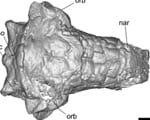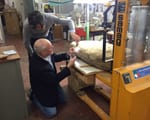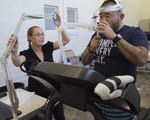“Weyand says there’s no ideal weight or height for sprinting fast, but that the world’s best have something in common — they apply greater ground force, a rapid punch to the ground, when their feet contact the track.” — The Globe and Mail
Journalist Rachel Brady referenced the research of SMU biomechanics expert Peter Weyand for an article in the news blog The Roar examining the potential for humans to continue improving strength and speed beyond what has already been achieved.
Porter quotes Weyand for his expertise on the mechanics of running and speed of world-class sprinters like Usain Bolt. The article “In perfect asymmetry” published Aug. 18, 2016.
Weyand, director of the SMU Locomotor Performance Laboratory, is one of the world’s leading scholars on the scientific basis of human performance. His research on runners, specifically world-class sprinters, looks at the importance of ground forces for running speed, and has established a contemporary understanding that spans the scientific and athletic communities.
In particular, Weyand’s finding that speed athletes are not able to reposition their legs more rapidly than non-athletes debunked a widespread belief. Rather, Weyand and his colleagues have demonstrated sprinting performance is largely set by the force with which one presses against the ground and how long one applies that force.
Weyand is Glenn Simmons Centennial Chair in Applied Physiology and professor of biomechanics in the Department of Applied Physiology and Wellness in SMU’s Annette Caldwell Simmons School of Education and Human Development.
Read the full story.
EXCERPT:
By Rachel Brady
The Globe and Mail
It’s hard to explain, but experts would love to try. Canadian sprinter Andre De Grasse, at 5-foot-9 and 154 pounds and with a running style that has his right arm flying behind him, doesn’t fit the conventional mold of a world class sprinter, reports Rachel Brady. So why’s he so fast?
Some experts in the biomechanics of sport have been watching Canada’s rising track star, Andre De Grasse, with fascination, dreaming of what it would be like to get the speedy phenom into their labs to find out how the first-time Olympian with the unconventional style runs so fast.
The 5-foot-9, 154-pound sprinter is shorter and less muscular than most of his opponents. He doesn’t start races out of the blocks particularly well, and as he flies down the track, his right arm swings backward in a quirky sort of way. To boot, the 21-year-old youngster took up sprinting less than four years ago. Yet De Grasse, who ran the 100-metre dash in 9.91 seconds to capture an Olympic bronze medal on Sunday, is defying many conventional beliefs about how a world-class sprinter should look and move.
The youngster from Markham, Ont., repeatedly pumps his outstretched right arm behind him when hitting his top speed during a race; meanwhile his left arm is bent and pumping in a more typical way.
The asymmetry is in sharp contrast to most of his opponents, who typically pump bent arms at both sides. De Grasse told a reporter from the International Association of Athletics Federations website last year that he attributes that extended right arm swing to an imbalance in his hips caused by a minor basketball injury in his childhood.
The experts say it’s no surprise that De Grasse is being left to run the way he’s most comfortable.
… One expert with experience testing world-class sprinters in a locomotor performance lab says arms have little effect on what is most important to elite sprinting – ground-reaction forces.
“His arm swing is not at all consequential to performance,” said Peter Weyand, professor of applied physiology and biomechanics at Southern Methodist University in Dallas, Texas. “The arms are light pendulums that allow runners to stay balanced as they execute strides. Differences in the arm’s motion and how it’s angled at the elbow really doesn’t matter to the sprinter’s velocity and the interaction between the feet and the ground. Some of the old guard still think arm motion really matters, but most today realize it’s not that consequential. The old guard might have tried to bend a sprinter’s elbow into place, but they wouldn’t have been able to offer much scientific data about why they were doing it.”
Read the full story.
Follow SMU Research on Twitter, @smuresearch.
For more SMU research see www.smuresearch.com.
SMU is a nationally ranked private university in Dallas founded 100 years ago. Today, SMU enrolls nearly 11,000 students who benefit from the academic opportunities and international reach of seven degree-granting schools. For more information, www.smu.edu.
SMU has an uplink facility located on campus for live TV, radio, or online interviews. To speak with an SMU expert or book an SMU guest in the studio, call SMU News & Communications at 214-768-7650.



 SMU biochemists and students probe biochemistry of membrane proteins that thwart cancer chemotherapies
SMU biochemists and students probe biochemistry of membrane proteins that thwart cancer chemotherapies One of the most significant Etruscan discoveries in decades names female goddess Uni
One of the most significant Etruscan discoveries in decades names female goddess Uni Textbook theory of how humans populated America is “biologically unviable,” study finds
Textbook theory of how humans populated America is “biologically unviable,” study finds Students grasp abstract math concepts after they demonstrate them with arm motions
Students grasp abstract math concepts after they demonstrate them with arm motions Geohazard: Giant sinkholes near West Texas oil patch towns are growing — as new ones lurk
Geohazard: Giant sinkholes near West Texas oil patch towns are growing — as new ones lurk Wildfire on warming planet requires adaptive capacity at local, national, int’l scales
Wildfire on warming planet requires adaptive capacity at local, national, int’l scales Early armored dino from Texas lacked cousin’s club-tail weapon, but had a nose for danger
Early armored dino from Texas lacked cousin’s club-tail weapon, but had a nose for danger SMU physicists: CERN’s Large Hadron Collider is once again smashing protons, taking data
SMU physicists: CERN’s Large Hadron Collider is once again smashing protons, taking data Nearby massive star explosion 30 million years ago equaled brightness of 100 million suns
Nearby massive star explosion 30 million years ago equaled brightness of 100 million suns
 New look at Pizarro’s conquest of Inca reveals foot soldiers were awed by empire’s grandeur
New look at Pizarro’s conquest of Inca reveals foot soldiers were awed by empire’s grandeur Charity, social justice and earth-friendly activism replace big houses, diamond rings and ostentatious living for status seekers
Charity, social justice and earth-friendly activism replace big houses, diamond rings and ostentatious living for status seekers Text in lost language may reveal god or goddess worshipped by Etruscans at ancient temple
Text in lost language may reveal god or goddess worshipped by Etruscans at ancient temple Good news! You’re likely burning more calories than you thought
Good news! You’re likely burning more calories than you thought
